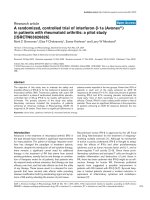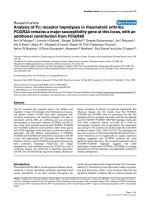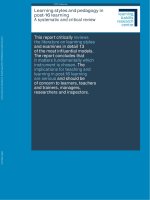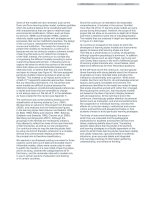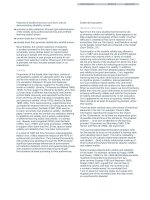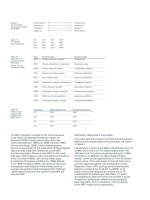The interplay of learning styles and use of idea generating techniques in the efl writing process a case study m a
Bạn đang xem bản rút gọn của tài liệu. Xem và tải ngay bản đầy đủ của tài liệu tại đây (825.39 KB, 103 trang )
VIETNAM NATIONAL UNIVERSITY – HO CHI MINH CITY
UNIVERSITY OF SOCIAL SCIENCES AND HUMANITIES
______________________
THE INTERPLAY OF LEARNING STYLES
AND USE OF IDEA-GENERATING
TECHNIQUES IN THE EFL WRITING
PROCESS: A CASE STUDY
A thesis submitted in partial fulfillment of the requirements for
the degree of Master of Arts (TESOL)
Submitted by
PHAN VĂN QUANG
Supervisor
NGUYỄN QUANG TIẾN, Ph.D.
Ho Chi Minh, March 2017
RETENTION AND USE OF THE THESIS
I hereby state that I, PHAN VAN QUANG, being the candidate for the
degree of Master of TESOL, accept the requirements of the University
relating to the retention and use of Master’s Thesis deposited in the Library.
In terms of these conditions, I agree that the origin of my thesis
deposited in the Library should be accessible for purposes of study and
research, in accordance with the normal conditions established by the Library
for the care, loan or reproduction of thesis.
Ho Chi Minh City, May 2017
PHAN VAN QUANG
i
CERTIFICATE OF ORIGINALITY
I hereby certify my authorship of the thesis submitted today entitled:
“THE INTERPLAY OF LEARNING STYLES AND USE OF IDEAGENERATING TECHNIQUES IN THE EFL WRITING PROCESS: A
CASE STUDY”
In term of the statements of requirements for thesis in Master’s
Programs issued by the Higher Degree Committee.
Ho Chi Minh City, May 2017
PHAN VAN QUANG
ii
ACKNOWLEDGEMENT
I wish to express my deepest gratitude to my thesis adviser Dr. Nguyen
Quang Tien for his guidance and support throughout my thesis writing. His
insightful discussions, valuable comments, enthusiasm and patience with me
played a crucial role in the preparation and completion of this thesis.
Next, my profound thanks are expressed to the International Programs
of Ho Chi Minh City University of Technology for permission for carrying
out this thesis. I also thank Mr. Vo Trong Nguyen, my colleague, for his
enthusiastic cooperation and helpful suggestions as well as the students at
HCM university of Technology for their participation in the survey for my
research.
On a more personal note, I need to thank my family for their love and
encouragement during my studies, especially during the time when I wrote
the thesis.
iii
ABSTRACT
Writing plays an important mode of communication and is one of the
most difficult skills in English language learning and teaching. Therefore, it
has gained considerable attention both from researchers and teachers.
However, little research has been found on the investigation of the interplay
of English writing skills and learners’ learning styles. In the context of EFL
(English as a foreign language) in Vietnam, few studies have been conducted
to explore this issue. The current study, therefore, aimed at investigating the
interplay of learning styles and the use of idea-generating techniques in the
EFL writing process. This study was conducted at Ho Chi Minh City
University of Technology in 2015. Twenty one students participated in the
questionnaire surveys, the think-aloud protocol, and the semi-structured
interview. On the basis of the results of this research, it can be concluded that
in most cases, the choice of techniques is a matter of habit or convenience,
and in few cases, the choice of techniques is made under the influence of the
writer’s learning style preference. Indeed, only the visual learners show
consistency in choosing their idea-generating technique (mind-mapping)
while other types of learners do not show consistency in their choice. Also,
some implications for both instructors and students were considered.
iv
ABBREVIATIONS
EFL
: English foreign language
ESL
: English second language
HCMUT
: Ho Chi Minh University of Technology
L1
: Language one
L2
: Language two
SUITPS
: Survey of Using Idea- Generating Techniques in Prewriting Stage
BA
: Bachelor
PLSPQ
: Perceptual Learning Style Preference Questionnaire
v
TABLE OF CONTENTS
RETENTION AND USE OF THE THESIS............................................................i
CERTIFICATE OF ORIGINALITY..................................................................... ii
ACKNOWLEDGEMENT...................................................................................... iii
ABSTRACT ..............................................................................................................iv
ABBREVIATIONS ...................................................................................................v
TABLE OF CONTENTS.........................................................................................vi
LIST OF FIGURES ..................................................................................................x
LIST OF CHARTS ..................................................................................................xi
CHAPTER ONE........................................................................................................1
INTRODUCTION.....................................................................................................1
1.1.Background to the Study.......................................................................................1
1.2.Statement of the Problem ......................................................................................4
1.4.Purpose of This Study ...........................................................................................4
1.6.Significance of the Study ......................................................................................5
1.7.Organization of the Study .....................................................................................6
CHAPTER TWO ......................................................................................................8
LITERATURE REVIEW.........................................................................................8
2.1.Cognitive Model of Writing Process ....................................................................8
2.1.1.Task Environment ..............................................................................................8
2.1.2.Long Term Memory...........................................................................................8
2.1.3.Writing Process ................................................................................................10
2.1.3.1.Planning.........................................................................................................10
2.1.3.1.1.Generating Ideas.........................................................................................11
2.1.3.1.2.Organizing..................................................................................................14
2.1.3.1.3.Goal Setting................................................................................................15
2.1.3.1.4.Translating..................................................................................................16
2.1.3.1.5.Reviewing ..................................................................................................16
2.1.3.1.6.The Monitor ...............................................................................................16
vi
2.2.Learning Styles....................................................................................................17
2.2.1.Definition .........................................................................................................17
2.2.2.Different Kinds of Learning Styles ..................................................................19
2.2.3.Characteristics of Visual, Auditory, and Kinesthetic Learners........................20
2.2.3.1.Visual Learners .............................................................................................21
2.2.3.2.Auditory Learners .........................................................................................22
2.2.3.3.Kinesthetic learners.......................................................................................23
2.3.Research on Writing Process and Learning Styles .............................................23
2.3.1.Research on Writing Process ...........................................................................23
2.4.An Overview of Relevant Research to Learning Styles .....................................26
2.5.Conclusion...........................................................................................................30
2.6. Conceptual Framework ......................................................................................31
2.6.Summary... ..........................................................................................................33
CHAPTER THREE ................................................................................................35
METHODOLOGY..................................................................................................35
3.1.Research Site .......................................................................................................35
3.2. Participants .........................................................................................................36
3.3. Research Questions ............................................................................................36
3.4.1. Perceptual Learning Style Preference Questionnaire (PLSPQ)......................37
3.4.2. Think-Aloud Protocol .....................................................................................39
3.4.4. Semi- Structured Interview .............................................................................43
3.5.Data Collection Procedure ..................................................................................44
CHAPTER FOUR...................................................................................................46
FINDINGS AND DISCUSSIONS..........................................................................46
4.1.Findings...............................................................................................................46
4.1.1.Research Question One ....................................................................................46
4.1.2.Research Question Two ...................................................................................47
4.1.2.1.The Use of Idea-Generating Techniques ......................................................48
4.1.2.2.The Causes of Using Idea-Generating Techniques.......................................50
4.1.2.2.1.Data from the Think-Aloud Protocol .........................................................50
vii
4.1.2.2.2.Data from the Semi-Structured Interview..................................................51
4.1.3.Question Three .................................................................................................52
4.1.3.1.The Interplay between Learning Styles and Use of Idea-Generating
Techniques in the Think-Aloud Protocol..................................................................52
4.1.3.2.The Interplay between Learning Styles and Use of Idea-Generating
Techniques after the Writing Conference .................................................................53
CHAPTER FIVE.................................................................................................... 60
IMPLICATIONS AND RECOMMENDATIONS.............................................. 60
4.2.Discussions..........................................................................................................54
4.2.1.Research Question One ....................................................................................54
4.2.2.Research Question Two ...................................................................................55
4.2.3.Research Question Three .................................................................................56
4.2.4. Summary .........................................................................................................59
5.1.Implications.........................................................................................................60
5.1.1.For the EFL Teachers.......................................................................................60
5.1.2.For EFL Learners .............................................................................................62
5.2.Limitations ..........................................................................................................64
5.3.Recommendations for Future Study ...................................................................65
5.4.Summary .............................................................................................................66
REFERENCES ........................................................................................................68
APPENDIX A ...........................................................................................................76
APPENDIX B ...........................................................................................................79
APPENDIX C ...........................................................................................................82
APPENDIX D ...........................................................................................................83
APPENDIX E............................................................................................................85
APPENDIX G ...........................................................................................................88
APPENDIX H ...........................................................................................................89
viii
LIST OF TABLES
CHAPTER FOUR
Table 4.1
Overall percentages of learning style preferences of EFL
students………………………………………………………54
ix
LIST OF FIGURES
CHAPTER TWO
Figure 2.1 Structure of Cognitive Models of Writing Process ..................... 11
Figure 2.2 Conceptual Framework................................................................ 34
x
LIST OF CHARTS
CHAPTER FOUR
Chart 4.1
Learning style preferences of EFL students…………………55
Chart 4.2
Use of idea-generating techniques…………………………….56
Chart 4.3
The relationship between learning styles and use of ideagenerating techniques in the pre writing stage in the think aloud
protocol………………………………………………………58
Chart 4.4
The relationship between learning styles and idea-generating
techniques students used after the writing conference…………59
xi
CHAPTER ONE
INTRODUCTION
This chapter provides readers with the background to the study by
displaying the statement of the problem, theoretical framework, conceptual
framework, purpose of the study, research questions, significance of the
study, and a brief overview of the thesis.
1.1. Background to the Study
This section provides a compelling understanding of the context of the
problem by highlighting the relevant facts about writing and learning styles of
learners in the EFL classroom.
For the past decades, EFL writing teachers have used the two writing
approaches to teach English composition: product-oriented approach and
process approach. In this process approach, the cognitive model of writing
process comprises three major elements: writing process, the task
environment and the writer’s long-term memory (Flower & Hayes, 1981).
The writing process consists of three main sub-processes: planning,
translating, and reviewing. During planning, students take information from
the task environment and from long-term memory, produce language
corresponding to information in the writer’s memory (translate), and read/edit
(review) to improve the quality of the text. The writing process approach
emphasizes a non-linear and dynamic process where “writers constantly shift
1
among pre-writing, writing, and revising tasks,” (Grabe & Kaplan, 1996, p.
19) during which they engage in the discovery and expression of meaning, but
are not preoccupied with form (Silva, 1990, p. 16). Flower and Hayes’ writing
process model revealed some important insights, among which is the idea
composing is a goal-driven behavior and that process is non-linear and
interactive.
The writing process approach focuses not only on the steps of writing
(planning, drafting, revising /editing) but also on writing strategies such as
selecting topics, generating ideas, and considering writing purpose and
audience. Existing research on writing processes and strategies (e.g.,
Matsumoto, 1995; Raimes, 1987; Leki, 1995; Zamel, 1983; Huynh, 2006; Le,
2009), some of which (e.g., Matsumoto, 1995; Raimes, 1987; Leki, 1995)
concluded that students took advantage of their past writing experiences in
L1 writing to achieve their current writing tasks and compensate for the lack
of linguistic and educational experiences. Besides, the research of Zamel
(1983), Huynh (2006), Le (2009) showed that students, especially unskilled
students ignored the use of idea-generating techniques in the planning stage;
furthermore, they got trouble in using idea-generating techniques to find ideas
for their essays, which play a very important role in the writing process
because writing is primarily about organizing information and communicating
meaning (Whilte, 1991). Actually, getting started is one of the most difficult
2
and inhibiting step in writing and idea-generating is particularly important as
an initiating process. Therefore, close attention should be paid to this stage.
Additionally, some writing strategies, such as having a sense of
audience, setting goals, organizing ideas, planning, monitoring, and
evaluating performances are believed to be teachable and independent of
language proficiency (Cumming, 1989; Roca de Larios, Murphy & Marin,
2002), for that reason, Weigle (2005) advocates that writing classes should
provide a balance between a focus on language and writing strategies.
It is believe that differences between skilled and unskilled writers based
on the coordination of knowledge (e.g. language, topic, and genre knowledge)
and the strategy use variable. Language learning strategies are defined as
“behaviors, techniques, or actions used by students to gain second or foreign
language skills” (Crookall et al., 1990). Much language learning strategy
research has revealed that students often lack awareness of language learning
strategies, and the most efficient way to heighten this awareness is to help
students be aware of their learning style preferences (Reid, 1995).
In the process of learning the language, language learning style is one
of the factors that determine the success of a language learner (Sharp, 2004).
Therefore, many researchers have investigated learning styles of learners in
various studies, which reflects the importance of learning styles in the field of
second and foreign language learning (Reid, 1987; Rossi-Le, 1995; Sharifah
Azizah & Wan Zalina, 1995; Stebbins, 1993; Rosniah Mustaffa, 2005;
3
Alsafi, 2010; Hyland, 1993; Trinidad, 2008; Ong, 2006; Mulalic, 2009;
Ismail, 2003; Nguyen, 2010; Luu, 2011). In these studies, the researchers
found that students’ learning preferences always influence the way that an
individual makes decisions and the choice of learning tasks suitable for the
learners because they have various ways of getting and processing
information. Thus, if students’ learning styles are known, teachers can expect
their students’ preferences, take advantage of their strengths and minimize
their weaknesses (Birkey & Rodman, 1995; Hartman, 1995).
1.2. Statement of the Problem
A careful review of existing research on EFL writing process and
language learning styles reveals several questionable issues. Much of EFL
writing research focuses on composing processes and strategies; there are
very few studies that deal with the matching of EFL writing process and
language learning styles. More importantly, there is scan research on the
interplay of the learning styles and use of idea-generating techniques in the
EFL writing process. Indeed, there is a clear need for a systematic
investigation into this issue.
1.3. Purpose of This Study
This research examined the interplay of learning styles and the use of
idea-generating techniques in the EFL writing process. The learning styles
investigated in this study fall into three categories: visual, auditory, and
kinesthetic. The idea-generating techniques in this study have eight types:
4
freewriting, outlining, mind mapping, cubing, listing, group discussion,
looping, and wh-questions.
1.4. Research Questions
This study addresses the following research questions:
1) What are students’ learning styles?
2) What idea-generating techniques do students frequently use in the
prewriting stage?
3) How are the learning styles related to the use of idea-generating
techniques in the EFL writing process?
1.5. Significance of the Study
Idea-generating techniques are frequently used in the prewriting stage
of English writing process in English writing classes. They are showed the
English teaching guidelines for English teachers. However, how they are used
in writing classes is not fully explored. Learning style is another important
factor of students’ foreign language learning. Sarasin’s (1999) and Brown’s
(2007) study showed that students respond differently in learning EFL
depending on what type of learners they are. Therefore, the relationship
between types of learners and their use of idea-generating techniques in the
EFL writing process is to be studied. Thus, the results of this research would
contribute both theoretically and practically to the effective teaching of the
writing skills and raise a greater awareness of various learning styles which
clearly influence the learners’ performance in writing. At a theoretical level,
5
this study adds much needed information to the body of literature related to
the relationship of learning styles of learners and their use of idea-generating
techniques. At a practical level, the findings of this study may help EFL
teachers to make informed decisions to select appropriate idea-generating
techniques that can facilitate EFL students’ writing process, and provide a
theoretically based module to train their students. It may also help to inform
EFL students of some successful pre-writing strategies that can enhance their
writing quantity and quality.
1.6. Organization of the Study
The current research is divided into five chapters. Chapter one
introduces the research background, discusses the statement of the problem,
establishes the theoretical framework, the conceptual framework, explains the
purpose of the study, and states the research questions. Chapter two reviews
relevant literature related to the cognitive writing process model proposed by
Flower and Hayes (1981) that provides theoretical basic for the current
research; research on EFL writing process and the impact of learning styles on
the learning process are also discussed in this chapter. The last section of
chapter two examines the studies on the learning styles. Chapter three
discusses the research design, the study context, the instruments, and data
collection. Chapter four deals with the research findings and presents the
results of both qualitative and qualitative analyses that answer the three
6
research questions of this study. The final chapter discusses the pedagogical
implications, and suggests further research.
7
CHAPTER TWO
LITERATURE REVIEW
This chapter reviews existing literature on both the writing process and
learning styles. It includes three sections. The first section provides the
cognitive writing process model proposed by Flower and Hayes (1981) that
serves as the theoretical basic for the current research. The second section
examines the impact of learning styles on a learner’s learning process. The
third section examines research on both the writing process and learning
styles.
2.1. Cognitive Model of Writing Process
One of the most influential cognitive models of the writing process
was proposed by Flower and Hayes (1981). The model reveals the act of
writing as comprising of three major elements, which are task environment,
long term memory and writing process. (Figure 2.1)
2.1.1. Task Environment
Flower and Hayes (1981) stated that task environment involves the
things the writer needs to consider, the things outside such as the topic
chosen by the writers, the audience of the essay which determine the way the
writer writes, and the text he/she produce.
2.1.2. Long Term Memory
According to Flower and Hayes (1981), long term memory involves
8
the writer’s background knowledge about the topic, recognition of the
appropriate information and decision on the suitable writing plan to fit the
rhetorical situation of the essay in order that the content is relevant to the
audience.
Figure 2.1 Structure of Cognitive Models of Writing Process (Flower and
Hayes, 1981, p 31)
9
2.1.3. Writing Process
Flower and Hayes (1981) maintained that the writing process involves
the planning made by the writer before writing, the translation of ideas into
words while writing, and the review, evaluation and revision of the essay
before presentation to the audience.
2.1.3.1. Planning
It is said that planning is the act of figuring out how to get from here to
there, i.e., making a detailed plan, but in Flower and Hayes’ model, the term
“Planning” is used in its much broader sense. According to Flower and Hayes
(1981), in the planning process writers form an internal representation of the
knowledge that will be used in writing. This internal representation is likely to
be more abstract than the writer’s prose representation will eventually be. For
example, a whole network of ideas might be represented by a single key
word. Moreover, this representation of the writer’s knowledge will not
necessarily be made in language, but could be held as a visual or perceptual
code, e.g., as a fleeting image that the writer must then capture in words.
Flower and Hayes (1981) stated that planning, or the act of building
this internal representation, involves a number of sub-processes. The most
obvious one is the act of generating ideas, which includes finding relevant
information from long-term memory. Sometimes this information is so well
developed and organized in memory that the writer is essentially generating
standard written English. However, in some cases, writers may generate only
10
small parts or unconnected, even contradictory thoughts. Planning contains
three sub-processes: generating ideas, organizing, and goal setting.
2.1.3.1.1. Generating Ideas
Generating ideas is the stage that writers use invention techniques to
explore ideas on a subject before he or she starts writing about it (Ilona Leki,
1998). Idea-generating techniques commonly used are freewriting, listing,
wh-questions, clusters or branches, looping, cubing, outlining, and group
discussions.
Freewriting
Ilona Leki (1982) divided freewriting into two kinds. The first type lets
the writers empty their mind temporarily of everyday concerns in order that
they can focus on the task at hand. In case the writers need to work on a
writing assignment but cannot focus on it, this type may help them to clear
their mind of the thoughts on their mind at that moment until they have gotten
all distractions out of their system. The other type; however, helps the writers
start exploring their ideas on a subject but have not yet decided what aspect of
that subject they want to explore. They can start it by writing down everything
coming to their mind on this topic. If writers cannot think of the words in
English, they write the words in their own language or leave a blank and keep
going.
11
Listing
According to Langan (2008), when writers decided on an aspect of a
topic to write about, they have to find out what they know about it and
anything related to it. This technique is similar to free writing in principle.
Writers also start writing down everything coming to their mind in words or
phrases rather than sentences.
Wh-questions
Langan (2008) maintained that by using wh-questions, writers usually
try to write the first sentence to answer the following questions: who, what,
when, where, why, how. These questions can be used to generate ideas. In this
way, they can identify the exact subject they are going to discuss.
Mind Mapping
According to Langan (2008), a mind map or spider gram is a strategy
used commonly to making notes on a topic, prior to writing. Writers start by
writing the subject of their composition in the middle of a piece of paper and
write down all the things which they associate with it. They continue this
process by exploring associations for each of the things they have written
down.
Looping
Langan (2008) acknowledged that looping is different from free writing
in focusing your thought on finding the core or center and pinpointing a main
idea on which to elaborate.
12
Cubing
According to Langan (2008), cubing helps writers look at an idea from
six different points of view, each of which presents one of the six sides of a
cube. The subject will be looked at from these six angles in order that writers
have several perspectives on the subject. The following angles of the topic
can be examined One of the following angles of the topic examined.
Describe it. (What does it look like? What do you see?)
Compare it. (What is it similar to? What is it different from?)
Analyze it. (What is it made of? What are its parts?)
Associate it. (What does it remind you of? What do you associate it
with?)
Apply it. (What can you do with it? What can you use it for?)
Argue for or against it. (Take either position. Give any reasons, even
crazy ones.)
Outlining
Langan (2008) said that outlining can be a transition between inventing
and writing a first draft. It is considered as a plan for writing and extremely
useful in dividing up the big task of writing a formal paper into the much
more manageable task of writing small parts that will eventually make a
unified and organized whole.
13




